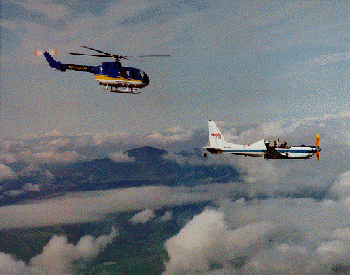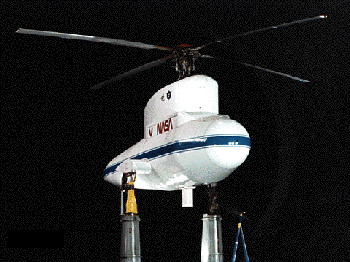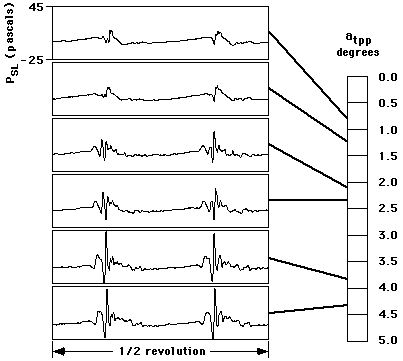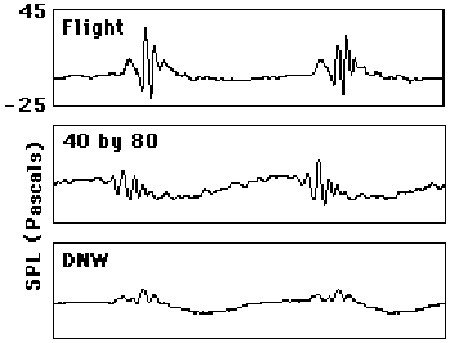In-Flight Rotorcraft Acoustics Program
BO 105 Flight Tests

Fig. 1 The BO 105 in formation with the YO-3A.
Measurement of BO 105 BVI Noise
Acoustic measurements of a Messerschmitt-Bölkow-Blohm (MBB) BO 105 helicopter in flight were compared with acoustic measurements of a full-scale BO 105 rotor tested in the 40- by 80-Foot Wind Tunnel at NASA Ames Research Center and with acoustic measurements of a small-scale BO 105 rotor tested in the Deutsch-Niederländischer Windkanal (DNW) (Signor et al., 1994). Significant differences were seen in both the magnitude and shape of the blade-vortex interaction (BVI) events in the 40- by 80-Foot Wind Tunnel data and DNW data, as compared to the flight data. The rotor wakes in the 40- by 80-Foot Wind Tunnel and DNW were concluded to be different from the rotor wake occurring in flight. The differences in the respective wakes were primarily attributed to different trim conditions, wind tunnel wall effects, different shaped bodies underneath the rotors, and wind tunnel turbulence levels.
Test Summary
The NASA Ames YO-3A fixed wing aircraft was flown in formation with a production MBB BO 105 helicopter, as shown in Figure 1. The YO-3A tail-mounted microphone was located below and in front of the helicopter, to measure the BVI noise generated on the advancing side of the rotor.
Acoustic measurements of a full-scale BO 105 rotor were made in the 40- by 80-ft test section of the National Full-Scale Aerodynamics Complex (NFAC). All four production rotor blades used in the wind tunnel tests had various instrumentation installed (strain gages, surface pressure taps and accelerometers). The BO 105 rotor, Rotor Test Apparatus (RTA), and microphone as installed in the 40- by 80-ft test section are shown in Figure 2. The microphone was the same type used in flight (0.5 in pressure-type condenser microphone, frequency response of 5 Hz to 20 kHz) and was mounted on an acoustically treated and faired stand, hard-mounted to the wind tunnel floor.

Fig. 2 The BO 105 rotor on the RTA.
Acoustics data were acquired in two separate test entries in the DNW. The same 0.4058-dynamically scaled BO 105 rotor and similar test set-ups were used in both tests (rotor radius = 6.54 ft). The tests were conducted in the open jet, anechoic test section configuration. The microphone was the same type used in flight. The microphone location was nominally the same as in the 40- by 80-Foot Wind Tunnel and flight.
Results
Examples of acoustic pressure (Sound Pressure Level, SPL) time histories from flight are presented in Figure 3. The vertical scale of each SPL time history, in Pascal's, is identical: -25 Pa to +45 Pa. A half revolution is shown in each time history. Tip-path-plane angle variations were achieved by varying rate of descent while all other parameters were held constant; effective tip-path-plane angle is shown on the vertical bar next to the data plots. The dramatic change in the shape of the acoustic waveform as BVI reaches a maximum is clearly visible.

Acoustic pressure time histories from flight, the 40- by 80-Foot Wind Tunnel and the DNW for the same test conditions are compared in Figure 4. Significant differences in the waveforms are evident. Although these adverse results do not occur for all acoustics data, the inability to consistently match flight and wind-tunnel data remains the primary motivation for further research under IRAP.

Effects of trim of BO 105 BVI Noise
A concern arising from this initial comparison between the flight and wind tunnel data was whether the differences in rotor trim were a major contributor to differences in the BVI noise waveforms. During the 40- by 80-Foot Wind Tunnel test, the rotor was trimmed to zero flapping; during the flight, the rotor was trimmed to balance moments on the helicopter.
The effect of rotor trim on BVI noise was investigated in a subsequent test of the BO 105 rotor in the 40- by 80-Foot Wind Tunnel by setting up on flight trim conditions. Small longitudinal and lateral cyclic excursions about the flight trim condition were input to the rotor to account for small trim variations which occur in flight. No significant effects on measured BVI noise were observed. In addition, during the latest testing of the small-scale BO 105 rotor in the DNW, the measured BVI noise time histories were very similar to those acquired in the 40- by 80-Foot Wind Tunnel. Trim variations were also performed during this test, with no observable effect of trim on BVI noise.
The differences between the BVI noise measured in the wind tunnel and flight, for the BO 105 rotor, cannot be reliably attributed to differences in rotor trim. Further research is needed to understand the effects of trim on BVI noise for full-scale rotors (For small-scale effects, see Burley & Martin, 1988.)
For a different perspective on these issues, see the discussion of BO 105 blade-pressure differences in Heller, et al., 1996. For more detailed information on the IRAP flight-test, see Signor et al., 1994.
Related Publications:
Burley, C. L. and Martin, R. M. "Tip-Path-Plane Angle Effects on Rotor Blade-Vortex Interaction Noise Levels and Directivity." 44th Annual Forum of the American Helicopter Society, Washington, D. C., June 1988.
Heller, H., Buchholz, H., Schultz, K.-J., Ahmed, S. R., and Splettstoesser, W. "Helicopter Rotor Blade Aeroacoustics: A Comparison of Model-Scale Wind Tunnel and Full-Scale Flight Test Results." ICAS-96-1.8.1, 20th ICAS Conference, Sorrento, Italy, September 1996.
Signor, D. B., Watts, M. E., Hernandez, F. J., and Felker, F. F., "Blade-Vortex Interaction Noise: A Comparison of In-Flight, Full-Scale, and Small-Scale Measurements." American Helicopter Society Aeromechanics Specialists Conference, San Francisco, CA, January 1994.
See also the references page.
Point of Contact:
C. W. Acree
NASA Ames Research Center
Moffett Field CA 94035-1000